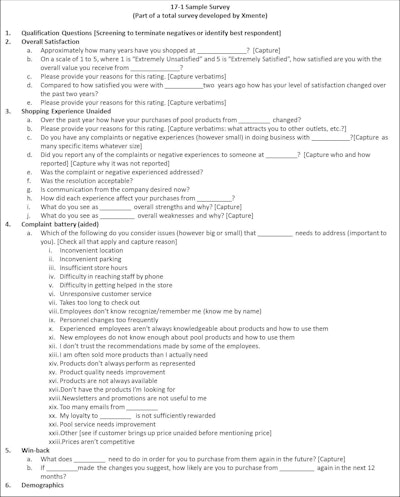My last article presented a three-step process for winning back lost customers and focused on step one: analyzing point-of-sale data to identify your most desirable lost customers. This post will highlight the second step: How to survey lost customers to uncover their reasons for defection.
Purpose and payoff
The purpose for the survey is to gain insights to improve customer retention and win-back. The payoff comes when you successfully implement “save” efforts for at-risk customers and create reactivation promotions to win back desirable lost customers. The simple fact is that dialogue with former customers is fundamentally important to pinpoint ways to improve product and service delivery, correct miscommunications and identify new opportunities.
The process
First determine who will actually conduct the customer research: your company, or an experienced outside firm? If you have the resources, it can be tempting to do it yourself, but we wouldn't suggest it. Customers often hesitate to complain or voice true feelings when talking directly to the retailer or his/her staff. (This is a fundamental truth in the market research world. Companies usually receive more authentic information when hiring an outside firm to conduct the research.)
In addition, capacity and skills are limited, and there is too much potential for bias to enter the interview itself or the data collection and interpretation activities. Here are some high-level considerations for a survey process.
- Designing the survey is a critical activity, since it is the basis for accurate interpretation and results. The figure below provides a sample of the survey we developed; it covers overall satisfaction, shopping experience, reasons customers have defected, win-back probability and some basic pool ownership demographics. If you would like a complete copy, just send me an email and briefly tell me why.
- Participation incentives will likely need to be developed and offered in order to motivate former customers to take the time to participate. This usually requires some trial and error in order to identify the most effective incentive offer for a particular customer segment.
- There must be a sufficient number of survey respondents in order to draw reasonable conclusions. Otherwise there is a risk of making generalizations that are not valid. We find that with a well-segmented target group, 75 to 100 respondents are sufficient to deliver a reasonable balance between confidence and cost.
- Lastly it is time to conduct the survey and analyze the results. Research has found that up to 30 percent of “lost customer” survey respondents will tell you what you can do to win them back. Our findings are similar.

Winning back lost customers
Getting a customer to return can be accomplished in many different ways. However, what all successful win-back programs have in common is they are proactive with targeted, sound initiatives rather than the occasional hit-and-run activity. A win-back program can range from promotional offers to service-oriented customer coddling, but all successful programs are deliberate. They are measurable. And they are well thought-out through the use of surveys like this.
Your turn
Have you ever surveyed your most desirable lost customers? How did you determine which lost customers to contact and try to win-back? How did you determine what incentive to offer the customers? What did you find? If you have not attempted a win-back program, what are your thoughts about this exercise? What methods do you use to learn about why you have lost customers? How have you applied that knowledge to improve your business? What kind of help could you use?
Read the previous post in this series: How to Win Back Lost Customers in 3 Steps











































